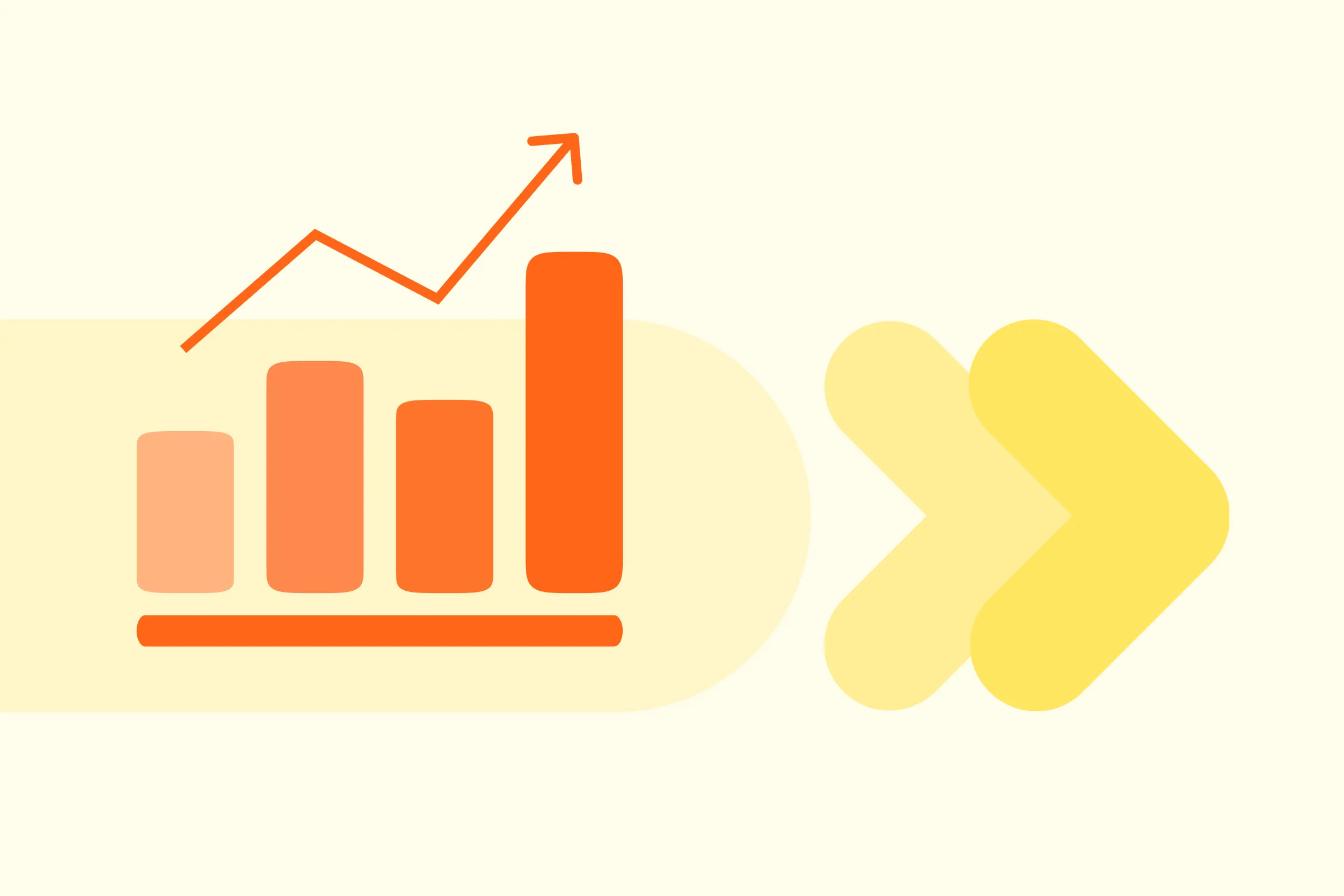B2B SaaS Marketing Trends 2025: What Top Agencies Are Seeing Right Now
Anastasiya Khvin
October 29, 2025

This isn't going to be one of those sanitized trend reports where every marketing agency says the same safe things. We're going to talk about real changes we're seeing in how B2B buyers actually behave, how marketing teams are restructuring themselves, and what's genuinely driving pipeline versus what just sounds good in a LinkedIn post.
Trend#1: AI and Automation Are Rewriting B2B Marketing Strategies (Not Just Assisting Them)
Nobody's saying this out loud yet, but AI isn't just making marketers more efficient. It's changing what a marketing team is.
We recently ran campaigns where AI tools handled audience segmentation, ad creative testing, and bid optimization all at once. Stuff that used to require three different people and weekly strategy meetings. The AI didn't just assist our team; it became part of the team.
How Marketing Teams Are Using AI Beyond Content Creation
Everyone's obsessing over AI-generated content. Cool. We get it. ChatGPT can write a blog post. But that's like using a Ferrari to drive to the grocery store. You're missing the entire point.
The B2B marketers actually winning right now? They're using AI for predictive analytics that tells them which accounts will convert in the next 30 days. They're analyzing thousands of customer conversations to surface patterns no human could spot. One of our clients in the analytics space saw a 60% jump in qualified leads when we implemented AI-driven audience modeling. Not because we worked harder, but because AI found patterns in their customer data that we wouldn't have discovered.
.webp)
Gartner research on AI in marketing confirms this shift, noting that AI is enhancing experiences and choice architecture to guide customer decisions at scale.
If you're curious about specific AI tools that go beyond the basics, we've compiled a list of 15 AI marketing tools that are actually moving the needle for B2B companies.
Some marketing roles are evolving so fast that the job description from 2023 is basically obsolete. If you're still doing manual campaign optimization and wondering why your conversion rates are flat... your competitors probably aren't.
Marketing Automation That Actually Responds to Buyer Intent Data
Marketing automation used to mean "send this email when someone downloads a whitepaper." That's adorable. And also completely insufficient for B2B marketing in 2025.
The automation we're building now responds to actual buyer behavior across multiple platforms. LinkedIn, your CRM, your product itself. When a prospect visits your pricing page three times, checks out competitor reviews, and then comes back to read case studies? Your automation should know that's a hot lead who needs a different message than someone who just discovered you exist.
Intent data changes everything here.In our paid search campaigns, we're now connecting Google Ads and Microsoft Ads directly to intent signals from platforms like Bombora and 6sense. When an account starts showing research behavior, our ad spend shifts automatically to prioritize them.
The B2B companies crushing it right now have marketing automation workflows that trigger based on LinkedIn engagement patterns, product usage behaviors, email interactions, and third-party intent signals. You don't need a massive team anymore. You need the right stack and someone who actually understands how to orchestrate it all.
Trend #2: The Death of Generic Personalization: First-Party Data Becomes Non-Negotiable
"Hi [First Name]" used to count as personalization. B2B buyers are over it.
Third-party cookies are basically dead. Or dying, or in whatever zombie state they're in this week. But that's forcing something that needed to happen anyway: real, meaningful personalization based on first-party data you actually own.
Most B2B companies treat data collection like checking a box. They collect it because everyone says they should, then it sits in their database unused.
We're working with SaaS companies that treat first-party data collection like a core business function. When you know what features a prospect uses in your product, what B2B content they consume, which webinars they attend, and how they interact with your sales team? That's when personalization starts driving revenue.
The companies we work with that have nailed this aren't just personalizing email subject lines. They're dynamically changing their entire website experiance, their ad messaging, their sales outreach. Everything. All based on signals from their CRM and product analytics. Our analytics service helps SaaS companies integrate all these data sources to actually use what they're collecting.
One of our team leads always says: "Marketing rarely fails because of low traffic. The real leak is often deeper in the funnel." That's what first-party data helps you find. Where prospects are actually dropping off and why.
Trend #3: Thought Leadership Content Gets a Reality Check
The thought leadership space in B2B is crowded with people who have a lot of thoughts but not much leadership. The LinkedIn posts that all say the same thing. The generic articles that could've been written by anyone about anything. Today's B2B buyers are sophisticated; they can smell generic advice from a mile away.
Why B2B Buyers Are Tuning Out Surface-Level Expertise
What actually works? Original research. Data from your own campaigns. Specific, actionable insights that can only come from doing the actual work.
When we share case studies showing how we increased Originality.AI's conversion rate by 210% or helped Orion Labs increase their sales opportunities by 4X overall, that's not thought leadership. That's receipts.
The B2B brands winning right now are going deep on specific problems rather than staying shallow across broad topics. They're showing their work. They're sharing what failed, not just what succeeded. They're giving away valuable insights because they know true expertise can't be commoditized by AI or cheap content mills.
Influencer Marketing Finally Finds Its Place in B2B
We were skeptical about this one. B2B influencer marketing sounded like trying to force a B2C trend where it didn't belong. Turns out we were wrong.
B2B influencer marketing doesn't look like traditional influencer campaigns, though. It's not about follower counts or viral posts. It's about working with genuine experts who've earned trust in specific niches. CTOs who actually use your product, marketing leaders who've solved the problems your software addresses, consultants who recommend solutions to real clients.
These partnerships create thought leadership content that builds trust because it comes from people B2B buyers already respect. And in a market where everyone's promising the same outcomes, trust is basically the only sustainable competitive advantage.
Trend #4: Account-Based Marketing in 2025: Hyper-Targeted Meets Scalable
ABM used to require a massive budget and a team of specialists. Not anymore.
The technology caught up to the promise. We're running account-based marketing campaigns for mid-market SaaS companies that used to think ABM was only for enterprise plays. With the right marketing automation platform and intent data, you can create surprisingly personalized experiences at scale.
.webp)
According to Forrester research, 99% of those with an ABM team said their ABM programs delivered higher ROI versus traditional marketing programs. That's not a typo. 99%.
ABM in 2025 isn't a top-of-funnel play. It's a full-funnel strategy involving coordinated marketing efforts from marketing, sales, and even customer success. The best ABM programs don't end when someone becomes a customer. They use the same targeting and personalization principles for expansion and retention.
Most B2B marketing teams treat ABM like a seperate channel rather than an approach that should inform everything else they do. When you truly understand your ideal customer profile and can identify target accounts with precision, that insight should flow through your content marketing, your paid campaigns, your website experience. Everything.
Trend #5: Video Marketing Evolves: From Awareness to Deal Acceleration
Video isn't new. We know. But how B2B companies are using video content in 2025? That definitely evolved.
We're seeing video show up everywhere: embedded in sales emails to explain complex features, on pricing pages to overcome objections, in retargeting campaigns to re-engage cold leads. The shift is from using video purely for brand awareness to deploying it strategically throughout the entire funnel.
.webp)
According to HubSpot's 2025 State of Marketing Report, short-form video is now the number one content marketing format, with most marketers saying it offers them higher ROI than any other format.
A founder explaining their product vision in a slightly awkward selfie video? That often performs better than a $10k production with perfect lighting and a script. Why? Because people build trust through imperfection. Perfection feels manufactured.
One thing we've learned from our conversion rate optimization work: even the best ad campaign can't save a broken landing page or bad analytics. Same goes for video.If you're driving traffic to a page that doesn't convert, no amount of video polish will fix that.
Short-Form Video Takes Over B2B Social Channels
LinkedIn is basically becoming TikTok for professionals. The organic reach on native LinkedIn video is insane compared to other content formats.
B2B marketers who figured this out early are dominating social media marketing right now. They're posting 30-60 second videos that deliver one specific insight. No fancy editing, just valuable content delivered quickly.
The companies doing this well aren't trying to go viral. They're consistently showing up, building familiarity and trust. It's the compound interest of content marketing. Small, consistent deposits that add up over time.
Trend #6: Experiential Marketing Makes the Leap from B2C to B2B SaaS
This is one of the weirder B2B marketing trends 2025. But it's real.
B2B buyers are tired of being marketed to like robots. They want actual experiences. The SaaS companies investing in experiential marketing (high-value in-person events, unique virtual experiences, creative ways to interact with their brand) are building deeper relationships with prospects and customers.
This works because it shifts the dynamic from "we're trying to sell you something" to "we're creating value for you regardless of whether you buy." And counterintuitively, that often leads to more deals, not fewer.
One client hosts quarterly "anti-pitch" dinners in major cities. No sales agenda, just interesting conversations with people in their target market. Their close rate on attendees? Almost 70%. Because by the time someone's ready to buy, they already feel like part of the community.
Trend #7: The Convergence: How Marketing and Sales Alignment Is Actually Happening
We've been talking about marketing and sales alignment for what, a decade now? But it's finally happening in 2025. And not because people suddenly decided to play nice together. It's happening because the technology and data infrastructure now exist to make it work. Shared dashboards, real-time lead scoring, integrated CRM and marketing automation platforms that actually talk to each other.
Intent Data as the Bridge Between Marketing Efforts and Revenue
Intent data changed everything about the handoff between marketing and sales.
When marketing can see which accounts are actively researching solutions and sales can see which specific content those accounts consumed? Suddenly you're speaking the same language. Marketing isn't passing leads over the wall and hoping for the best; sales isn't complaining about lead quality because they have context about where each prospect is in their B2B buying journey.
.webp)
The B2B marketing teams we work with that nailed this are seeing shorter sales cycles and higher conversion rates. Because the entire go-to-market motion is finally optimized as one system instead of separate departments with conflicting incentives.
We see this play out in our LinkedIn Ads campaigns all the time. When we can show sales exactly which posts a prospect engaged with, which ads they clicked, what content they downloaded, the first sales call is completely different. The sales team isn't starting from scratch; they're continuing a conversation that marketing already started.
Emerging Trends to Watch: What Marketing Leaders Are Testing Now
Everything above? That's what's already working. But there's some experimental stuff happening that hasn't hit mainstream yet. Some of it will. Some of it probably won't. But the marketing leaders we work with are testing it anyway because that's how you stay ahead.
AI-Generated Content Meets Human Authenticity
AI can generate content at scale. But B2B buyers crave authenticity. So how do you square that circle?
The smartest marketing teams are using AI to handle the heavy lifting. Research, first drafts, optimization. While ensuring human experts add the insights, nuance, and voice that make content worth reading. We're testing this with our own content strategies. AI helps us identify topics, analyze what's working, and create frameworks. But the actual actionable insights about what we're seeing in campaigns? That's all human expertise.
The companies that'll win are the ones who figure out the right division of labor between AI tools and human marketers. Use AI to handle the scalable, repeatable stuff. Reserve human energy for strategy, creativity, and the kind of deep thinking that AI still can't replicate.
LinkedIn Becomes the Testing Ground for Performance Marketing
LinkedIn quietly became one of the most sophisticated B2B advertising platforms out there. The targeting capabilities. The intent signals. The integration with CRM systems. It's all there.
Data from Dreamdata's LinkedIn Ads Benchmarks Report shows that LinkedIn Ads deliver a 113% return on ad spend (ROAS). The highest among major platforms. That's not a small difference. That's LinkedIn fundamentally outperforming other channels for B2B.
We're seeing companies test everything on platforms like LinkedIn first because the audience is self-selecting and the feedback loops are fast. What works on LinkedIn often translates to other channels; what fails there usually fails everywhere else too.
In our paid social work, we use LinkedIn as the canary in the coal mine. New messaging angle? Test it on LinkedIn first. New value proposition? LinkedIn. The platform gives you feedback fast enough that you can iterate before rolling things out across your entire marketing mix.
If you're running LinkedIn ads and want to make sure your setup is solid, we put together a free LinkedIn Ads optimization checklist that covers the most common issues we see in accounts.
Future of B2B Marketing: Preparing Your Marketing Team for What's Next
The future of B2B marketing isn't about having the biggest budget or the most people. It's about having the right mix of technology, data, and human expertise. It's about moving fast and testing constantly.
At Aimers, our entire approach is built around this reality. We don't chase every shiny new trend. We test relentlessly, measure everything, and double down on what actually drives results for SaaS companies. That's why clients like ShipBob and Orion Labs stick with us. We're not executing tactics, we're evolving B2B marketing strategies based on what the data tells us.
The B2B marketers who'll thrive in 2025 and beyond are the ones who can balance technical sophistication with strategic thinking. Who can use AI and automation without losing the human touch that builds trust. Who can admit when they don't have all the answers and are willing to test their way to them.
The trends we've covered here aren't just observations.They're early signals of how B2B marketing is changing. Some of these trends will accelerate. Others might fade. But the underlying pattern is clear: marketing is becoming more data-driven, more automated, and somehow more human all at the same time.
If you're running marketing for a SaaS company and feeling like you're constantly playing catch-up with all these changes... you're not alone. That's literally why agencies like ours exist. Sometimes you need a team that's seeing these trends across dozens of companies to help you figure out which ones actually matter for your specific situation.
Want to talk about what this all means for your strategy? Or wondering where your ad budget might be silently leaking? A PPC audit can uncover those hidden inefficiencies. Or just reach out and we'll figure it out together.












